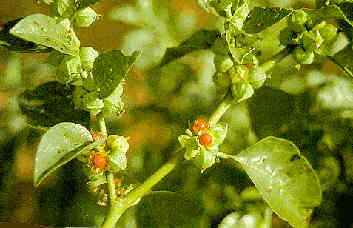
Plant Description
Caution & Interaction

Latin (botanical) name:
Withania somnifera
Common names: Winter Cherry, Indian Ginseng
Plant Description: The Ashwaganda plant is an evergreen perennial shrub which is usually found in the arid parts of India and has been found as far west as Israel. It sometimes grows as tall as seven feet and looks similar to a large potato plant. Although different parts of the plant have been used for medicinal purposes, the root is the primary source. The Latin name for the plant literally means "sweat of a horse" because the root smells like a damp horse.
Medicinal Properties & Uses: Ashwaganda is considered to be astringent, sedative, aphrodisiac, antibiotic, antiviral and diuretic. It is often used internally for indigestion, heart disease, arthritis, back pain, and fevers. Ashwaganda has also been effective in relieving insomnia, convalescence, nervous exhaustion, and impotence. In the cases of mental health, Ashwaganda helps to prevent mental exhaustion in those who extend their energies more than they replenish, and also aids in recovery for those who have already exhausted themselves.
Dosage: 30-60 drops in water or juice, 2-3 times daily or as needed. Shake well before using.
Cautions & Interactions: Do not take during pregnancy. Keep out of reach of children.
Efficacy Studies & Other Clinical Data:
Helpful Links:
Disclaimer (U.S. Only): These statements have not been evaluated by the FDA. These products are not intended to diagnose, cure, treat, or prevent any disease.
Common names: Winter Cherry, Indian Ginseng
Plant Description: The Ashwaganda plant is an evergreen perennial shrub which is usually found in the arid parts of India and has been found as far west as Israel. It sometimes grows as tall as seven feet and looks similar to a large potato plant. Although different parts of the plant have been used for medicinal purposes, the root is the primary source. The Latin name for the plant literally means "sweat of a horse" because the root smells like a damp horse.
Medicinal Properties & Uses: Ashwaganda is considered to be astringent, sedative, aphrodisiac, antibiotic, antiviral and diuretic. It is often used internally for indigestion, heart disease, arthritis, back pain, and fevers. Ashwaganda has also been effective in relieving insomnia, convalescence, nervous exhaustion, and impotence. In the cases of mental health, Ashwaganda helps to prevent mental exhaustion in those who extend their energies more than they replenish, and also aids in recovery for those who have already exhausted themselves.
Dosage: 30-60 drops in water or juice, 2-3 times daily or as needed. Shake well before using.
Cautions & Interactions: Do not take during pregnancy. Keep out of reach of children.
Efficacy Studies & Other Clinical Data:
Helpful Links:
Disclaimer (U.S. Only): These statements have not been evaluated by the FDA. These products are not intended to diagnose, cure, treat, or prevent any disease.